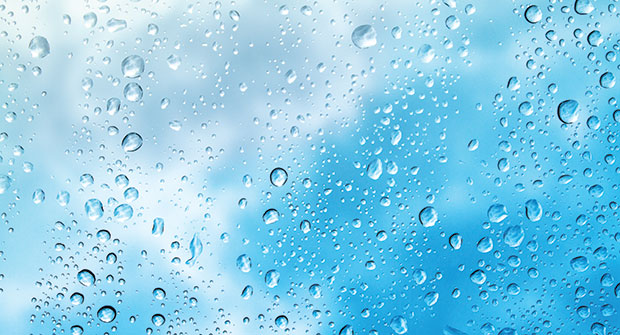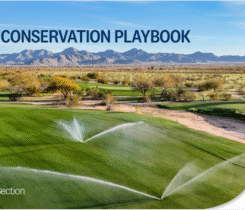Fertilization needs of warm-season turfgrass irrigated with saline water
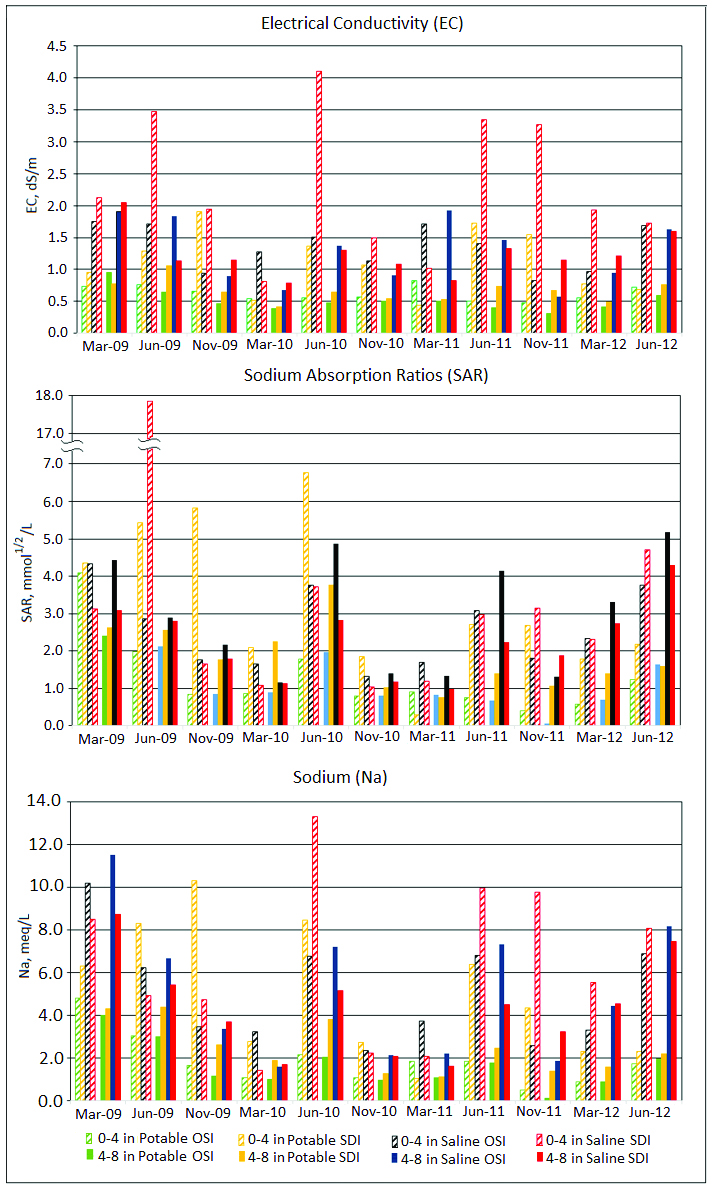
Electrical conductivity (EC, dS/m), sodium adsorption ratio (SAR, mmol1/2/L) and sodium content (Na, meq/L) from March 2009 to June 2012 at two root zone depths (0 to 10 and 10 to 20 cm) of turf irrigated with either potable (0.6 dS/m) or saline (3.1 dS/m) water from either overhead sprinkler irrigation (OSI) or a subsurface drip irrigation (SDI) system.
Irrigating turfgrass with potable water has become a contentious topic in the desert Southwest of the United States, as fresh-water supplies are dwindling and municipalities restrict or eliminate the use of high-quality drinking water for non-essential purposes, such as landscape irrigation. For this reason, researchers propose and investigate several water conservation strategies for use in turfgrass areas (12).
Non-potable water, such as treated effluent or saline groundwater, provides an alternative to using high-quality water for irrigation and is a potential solution to the growing shortage of potable irrigation water. However, saline groundwater and treated effluent contain a higher concentration of dissolved salts, which can negatively affect grass growth, turf quality and soil structure (4,14).
A second approach is to use irrigation systems considered more efficient than traditional overhead sprinkler irrigation (OSI) systems. Although OSI systems are the most commonly used irrigation systems for landscapes and golf courses, these systems can be inefficient because of losses such as overspray, run-off, wind drift and evaporation.
Subsurface drip irrigation (SDI) systems, on the other hand, apply water directly to the root zone, thereby avoiding the problems mentioned above (11). Many recommend such systems for use on residential lawns (23) and golf courses (9). However, few studies have examined whether or not it is possible to apply standard establishment and maintenance practices on SDI-irrigated turf.
Superintendents can establish both warm- and cool-season turfgrasses from seed and sod using SDI. On the other hand, SDI resulted in increased salt concentration in the root zone compared to irrigation with OSI using saline water (6,20,21,22,24,25).
Researching Warm-Season Grasses
More salt-tolerant than most cool-season grasses, warm-season grasses such as bermudagrass (Cynodon dactylon), zoysiagrass (Zoysia spp.) and seashore paspalum (Paspalum vaginatum) are the logical choice for turf areas where tolerance to saline water is necessary due to potable water restrictions (10).
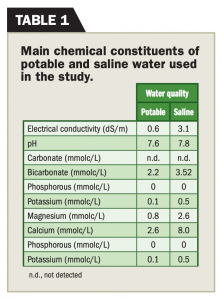 A dormancy period often follows the growing season of warm-season grasses, extending from the first frost until spring soil temperatures reach 50 degrees F or higher (26). During the dormancy period, the grasses are tan or brown and cannot recover from traffic or other injuries (3).
A dormancy period often follows the growing season of warm-season grasses, extending from the first frost until spring soil temperatures reach 50 degrees F or higher (26). During the dormancy period, the grasses are tan or brown and cannot recover from traffic or other injuries (3).
In addition, warm-season grasses are susceptible to winter injury in colder climates or delayed spring green-up (18). Species and variety selection can help shorten the dormancy period and increase market acceptance of warm-season grasses in transitional climate zones with long winter periods.
For example, seashore paspalum has been shown to provide a green color longer in the fall than bermudagrass, and the green-up of Yukon bermudagrass cultivar was faster in the spring than Princess 77 (13,19). Researchers conducted both studies in northern Italy, in a Mediterranean climate. Furthermore, certain aspects of turfgrass maintenance — such as fertilization, mowing and type of irrigation — can also affect quality, color and dormancy. Superintendents should consider this when evaluating turfgrasses for the length of dormancy. Fertilization affects the warm-season grass color, growth, yield and greenup. For instance, late fall application of nitrogen (N) fertilizer on bermudagrass can extend fall green color and accelerate green-up the following spring without winter damage (7,8,16,17,18,19).
![Turfgrass spring green-up (days of year [DOY] to reach percent of green cover) as affected by year and nitrogen rate (Princess 77 bermudagrass [low = 4 lbs. N 1,000 ft–2 year–1; high = 6 lbs. N 1,000 ft–2 year–1]; Sea Spray seashore paspalum [low = 2 lbs. N 1,000 ft–2 year–1; high = 4 lbs. N 1,000 ft–2 year-1]). Each sigmoidal data line represents an average of two water qualities (potable [0.6 dS/m] and saline [3.1 dS/m]), four fertilizers (liquid slow-release, granular slow-release, granular urea, and liquid urea) and three replications.](https://www.golfdom.com/wp-content/uploads/2022/08/Figure-2_R.jpg)
Turfgrass spring green-up (days of year [DOY] to reach percent of green cover) as affected by year and nitrogen rate (Princess 77 bermudagrass [low = 4 lbs. N 1,000 ft–2 year–1; high = 6 lbs. N 1,000 ft–2 year–1]; Sea Spray seashore paspalum [low = 2 lbs. N 1,000 ft–2 year–1; high = 4 lbs. N 1,000 ft–2 year-1]). Each sigmoidal data line represents an average of two water qualities (potable [0.6 dS/m] and saline [3.1 dS/m]), four fertilizers (liquid slow-release, granular slow-release, granular urea, and liquid urea) and three replications.
Fertilization Warm-Season Grasses
However, few studies have focused on the fertilization requirements of seashore paspalum. Once established, seashore paspalum requires less nitrogen fertilization than other turfgrass species (2). Seashore paspalum fairways, tees and athletic fields require nitrogen levels of 2 to 4 lbs. per 1,000 ft–2 annually. Published data on bermudagrass suggest that it requires higher nitrogen rates than seashore paspalum (5).
For example, researchers recommend nitrogen application rates of 4 to 8 lbs. N 1,000 ft–2 annually for bermudagrass fairways (1). Bermudagrass greens or athletic fields may require nitrogen fertilization rates of up to 2 lbs. N per 1,000 ft–2 per growing month (15).
The objective of this study was to investigate and compare the effects of different nitrogen fertilizers and rates on spring green-up, summer quality and fall color retention of Princess 77 bermudagrass and Sea Spray seashore paspalum when applying non-potable water through SDI. Limited information is available on how nitrogen fertilizers affect the color and quality of grasses when superintendents use saline water for irrigation. There is also a lack of studies that have examined the efficacy of different fertilizer types (granular versus liquid) under SDI.
![Turfgrass quality rating differences (1 = worst; 9 = best) as affected by four fertilizers (LSR, liquid slow-release; GSL, granular slow-release; UG, urea granular; UL, urea liquid) and nitrogen (bermudagrass [low = 4 lbs. N 1,000 ft–2 year–1; high = 6 lbs. N 1,000 ft–2 year–1]; seashore paspalum [low = 2 lbs. N 1,000 ft–2 year–1; high = 4 lbs. N 1,000 ft–2 year-1]). Each data point represents an average of nine seasons, two water qualities (potable [0.6 dS/m] and saline [3.1 dS/m]), and three replications. Bars followed by the same letter (Fisher’s protected LSD at α = 0.05) are not significantly different from one another (separately for each grass irrigation system).](https://www.golfdom.com/wp-content/uploads/2022/08/Figure-3_R.jpg)
Turfgrass quality rating differences (1 = worst; 9 = best) as affected by four fertilizers (LSR, liquid slow-release; GSL, granular slow-release; UG, urea granular; UL, urea liquid) and nitrogen (bermudagrass [low = 4 lbs. N 1,000 ft–2 year–1; high = 6 lbs. N 1,000 ft–2 year–1]; seashore paspalum [low = 2 lbs. N 1,000 ft–2 year–1; high = 4 lbs. N 1,000 ft–2 year-1]). Each data point represents an average of nine seasons, two water qualities (potable [0.6 dS/m] and saline [3.1 dS/m]), and three replications. Bars followed by the same letter (Fisher’s protected LSD at α = 0.05) are not significantly different from one another (separately for each grass irrigation system).
Experiment
We conducted a 3-year study at New Mexico State University in Las Cruces, N.M., to investigate the effects of different fertilization treatments on turf performance when applying water conservation strategies. These strategies include the use of non-potable saline irrigation water and the use of efficient subsurface irrigation systems.
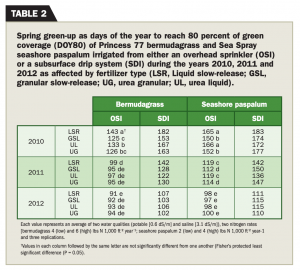 We irrigated two low water use warm-season grasses, Princess 77 bermudagrass (Cynodon dactylon) and Sea Spray seashore paspalum (Paspalum vaginatum), with either potable [Electrical Conductivity (EC) = 0.6 dS/m] or saline (EC = 3.1 dS/m) water from either an overhead or a subsurface drip irrigation system.
We irrigated two low water use warm-season grasses, Princess 77 bermudagrass (Cynodon dactylon) and Sea Spray seashore paspalum (Paspalum vaginatum), with either potable [Electrical Conductivity (EC) = 0.6 dS/m] or saline (EC = 3.1 dS/m) water from either an overhead or a subsurface drip irrigation system.
During the growing seasons (March 15 to November 15 of each year), crews fertilized the turf with four different fertilizers treatments. We applied a liquid slow-release, granular slow-release, granular urea and liquid urea at two rates: 2 and 4 lbs. N 1,000 ft–2 year–1 for Sea Spray and 4 and 6 lbs. N 1,000 ft–2 year–1 for Princess 77.
The fertilizer treatments were granular urea (46-0-0:N-P-K) (UG), urea liquid (46-0-0: N-P-K) (UL), and liquid slow release (Burley Green 18-2-3:N-PK) (LSR) (12 percent urea, 6 percent triazone nitrogen) (Grigg Brothers) applied every 15 days. The control treatment received a complete granular fertilizer with slow-release nitrogen (20-4-8:N-P-K) (GSR) every 45 days. Nitrogen in this fertilizer consisted of a blend of urea, sulfur-coated urea, ammoniated phosphate, muriate of potash and sulfate of potash magnesia (Helena Chemical Company).
The digital image analysis, visual quality ratings and normalized difference vegetation index determined spring green-up, summer quality and fall color retention.
Crews mowed turfgrasses twice weekly at the height of 0.5 inches with a walk-behind reel mower and removed clippings. The team collected composite soil samples separately for each treatment at depths of 0 to 4 and 4 to 8 inches in March, June and November of each year and analyzed them to determine changes in parameters relevant to soil salinity. Results of soil test analysis for all sampling dates during the experiment (Figure 1).
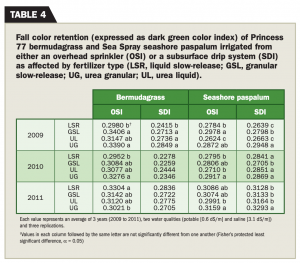 Discussion
Discussion
The combination of Princess 77 and overhead irrigation reached 80 percent green cover 35 (in 2010), 34 (in 2011) and 12 (in 2012) days faster than SDI-irrigated Princess 77 (Figure 2, Table 2).
Generally, sub-surface drip-irrigated grasses were slower to green-up than overhead irrigated ones (Figure 2). Sea Spray irrigated from the SDI system took 18, 28 and 15 days longer to reach 80 percent green cover in 2010, 2011 and 2012, respectively, than the sprinkler- irrigated counterparts (Table 2).
Regardless of the irrigation system, the turf quality of Sea Spray was always better for the higher fertilization rates (Figure 3). In contrast, different N-rates did not impact the visual appearance of OSI-irrigated Princess 77 and no clear trend was evident as to the impact of nitrogen rate on drip-irrigated Princess 77 (Figure 3).
Liquid fertilization negatively affected the summer quality of sprinkler-irrigated Sea Spray. During two of three summers, the visual quality of plots fertilized with either liquid slow-release or liquid urea was lower than Sea Spray fertilized with granular fertilizer.
Subsurface drip-irrigated Sea Spray and OSI-irrigated Princess 77 that received LSR showed greater quality when irrigated with saline water than with potable water (Figure 4). Also, UL combined with saline irrigation water resulted in greater turf quality on OSI-irrigated Sea Spray.
These results differed from OSI-irrigated Princess 77, for which UL and potable irrigation water resulted in greater turf quality than saline water. However, for all the other treatment combinations, water quality did not affect the visual appearance of turfgrasses, regardless of the fertilizer applied (Figure 4). Interestingly, despite higher salt concentrations in the root zones of turf irrigated with saline water for most of the sampling dates (Figure 2), turf quality was either not negatively affected or improved (Figure 4).
Granular urea applied at a high rate resulted in the darkest green Sea Spray compared to all other treatments (Table 3). We recorded the poorest fall color retention on OSI-irrigated Sea Spray on turf fertilized with low rates of UL. On SDI-irrigated Sea Spray, we observed the poorest fall color retention on GSR and UL applied at the low rate and LSR at the high rate (Table 3). The interaction between fertilizer type and the rate did not affect fall color retention in bermudagrass.
The type of fertilizer applied affected fall color retention for 10 of 12 treatment combinations (Table 4). However, as observed with our visual turf quality results, no one fertilizer had the same impact on Dark Green Color Index (DGCI) for all treatments in November. Of the 12 treatment combinations, granular urea applications resulted in best fall color retention on eight and GSL on seven of them, with Sea Spray showing better DGCI response to UG than Princess 77.









